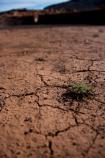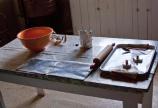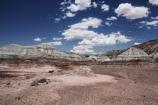Media Included
- Preservation Perseverance - Created by Northern Arizona University students, Jackie Philleo, Samantha Schutter, and Diandra Markgraf, the documentary, Preservation Perserverance, examines the challenges in preserving ancient ruins for future generations.
- Between the Layers - One of the best places to study Late Triassic terrestrial ecosystems is the Chinle Formation in Petrified Forest National Park (PEFO), Arizona. Here, sedimentary rocks ~220-210 million years old preserve a rich record of paleoenvironmental and biotic change. These strata are renowned for their preservation of fossil wood, leaves, and vertebrate animals, including early dinosaurs. They also created a record of the climate change, from more humid conditions recorded in older strata to arid conditions recorded in younger rocks. These Late Triassic environmental changes preserved in rocks at PEFO, and their relationship to observed changes in the species of fossil plants and animals found there, are a key to understanding how Late Triassic climate shaped the evolution of ecosystems on land. NAU student Ryan Gahris spent a day with PEFO paleontologist Bill Parker who explains how recent studies of Late Triassic geology and paleontology at PEFO document a sudden change in plant and vertebrate species in the middle of the Sonsela Member of the Chinle Formation, the major petrified wood bearing layer in the park. This change is the largest biotic turnover event recorded in the rock record at PEFO, and is associated with a distinctive red silcrete layer and may have been related to the impact of a large asteroid or comet in what is now Quebec, Canada.
- Wall to Wall - Canyon de Chelly National Monument preserves archaeological, historical, cultural and natural resources representing nearly 4000 years of human occupation by Ancestral Pueblo Indians, and historic and modern-day Navajo peoples. However, invasive plant infestations of tamarisk and Russian olive trees have altered stream channels and riparian ecosystems, and threaten traditional farming and ethnological uses by Navajo peoples. This video, created by Yffy Yossifor, Cassandra Chee and Brittany Tabor, chronicles how the National Park Service worked with residents of the canyon to restore it to the condition that the Navajo elders remember, when vegetation did not choke the canyon floor, and the canyon was visible from wall to wall.
- Experience: Coyote Gulch Backpacking - Glen Canyon National Recreation Area covers 1.2 million acres, stretching from Lees Ferry, Arizona northeast to Canyonlands National Park in Utah and encompassing magnificent vistas, geologic wonders, and a vast panorama of human prehistory and history. NAU student Ryan Gahris explores the history, the science and the beauty of Glen Canyon NRA in four videos and a photo gallery. This series is dedicated to portraying the area in all of its splendor and fragility.
- The Coronado Expedition of 1542 - Over the past 800 years, a reliable watering hole at the base of a sandstone bluff attracted Ancestral Puebloan settlers, conquistadores, and early American travelers to El Morro. They left their mark in the form of petroglyphs and historic inscriptions on what is known as “Inscription Rock”. Until 2007, the oldest physical evidence of Spanish presence at El Morro was the 1605 inscription of Juan de Onate. Archeological research in 2007, however, recovered several curious artifacts with dramatic implications that seemed to link El Morro with the first major Spanish foray into the Southwest: the 1540-1542 expedition of Captain General Vazquez de Coronado. As evidence emerged, researchers wanted to know, did Coronado pass by here? If so, this would set the monument’s Spanish Colonial history back decades earlier than previously thought. A few small, metal objects begin this intriguing, modern day detective story that would take researchers to sites thousands of miles from El Morro.
- A Day on the Lake - Glen Canyon National Recreation Area covers 1.2 million acres, stretching from Lees Ferry, Arizona northeast to Canyonlands National Park in Utah and encompassing magnificent vistas, geologic wonders, and a vast panorama of human prehistory and history. NAU student Ryan Gahris explores the history, the science and the beauty of Glen Canyon NRA in four videos and a photo gallery. This series is dedicated to portraying the area in all of its splendor and fragility.
- Historical Relevance: Lee's Ferry - Glen Canyon National Recreation Area covers 1.2 million acres, stretching from Lees Ferry, Arizona northeast to Canyonlands National Park in Utah and encompassing magnificent vistas, geologic wonders, and a vast panorama of human prehistory and history. NAU student Ryan Gahris explores the history, the science and the beauty of Glen Canyon NRA in four videos and a photo gallery. This series is dedicated to portraying the area in all of its splendor and fragility.
- Green Rangers and Park Stewards - Montezuma Castle and Tuzigoot National Monuments have embarked on a multi-pronged resource outreach effort to work with local schools, community groups, and families to engage youth, ranging from elementary to high school grades, at the monuments. NAU students Jim Benbow, Cori Cusker, Hannah Green, and Hanna Smolan conducted interviews of National Park Service staff and local community members for their documentary video which describes the Green Ranger program and the Park Stewards high school program. The Green Ranger program is for kids between the ages of 9-12 years and teaches them about native plants and habitat restoration in the field. The Park Stewards high school program was funded in part through the National Park Foundation and brings high school students to the monuments to learn about and practice habitat restoration techniques. Montezuma Well, where both programs are based,is part of Montezuma Castle National Monument in the Verde Valley of Arizona.
- The Park Of Present History - John Lorenzo Hubbell purchased what was to become the Hubbell Trading Post in 1878. The oldest continuously operating trading post on the Navajo Nation, Hubbell Trading Post is still providing goods for local residents as well as park visitors. This video was filmed over the course of one day at the Hubbell Trading Post and was created by multimedia journalist, Ryan Gahris.
- Simple Beauty - Glen Canyon National Recreation Area covers 1.2 million acres, stretching from Lees Ferry, Arizona northeast to Canyonlands National Park in Utah and encompassing magnificent vistas, geologic wonders, and a vast panorama of human prehistory and history. NAU student Ryan Gahris explores the history, the science and the beauty of Glen Canyon NRA in four videos and a photo gallery. This series is dedicated to portraying the area in all of its splendor and fragility.
In spring 2011, SCPN and the NAU School of Communication collaborated on a multimedia studies course focused on documenting park resources and resource projects. The class was taught by NAU professors Peter Friederici and Laura Camden.
Small teams of undergraduate students, working in photojournalism, audio documentary, or print journalism, travelled to parks to meet with park staff, record their impressions in multimedia formats, and then craft those raw materials into final products which included short videos and photo galleries.
Part of a series of articles titled SCPN-NAU School of Communication Collaboration.
Tags
- aztec ruins national monument
- canyon de chelly national monument
- chaco culture national historical park
- el morro national monument
- glen canyon national recreation area
- hubbell trading post national historic site
- montezuma castle national monument
- petrified forest national park
- tuzigoot national monument
- wupatki national monument
- swscience
- american southwest
Last updated: October 5, 2016




